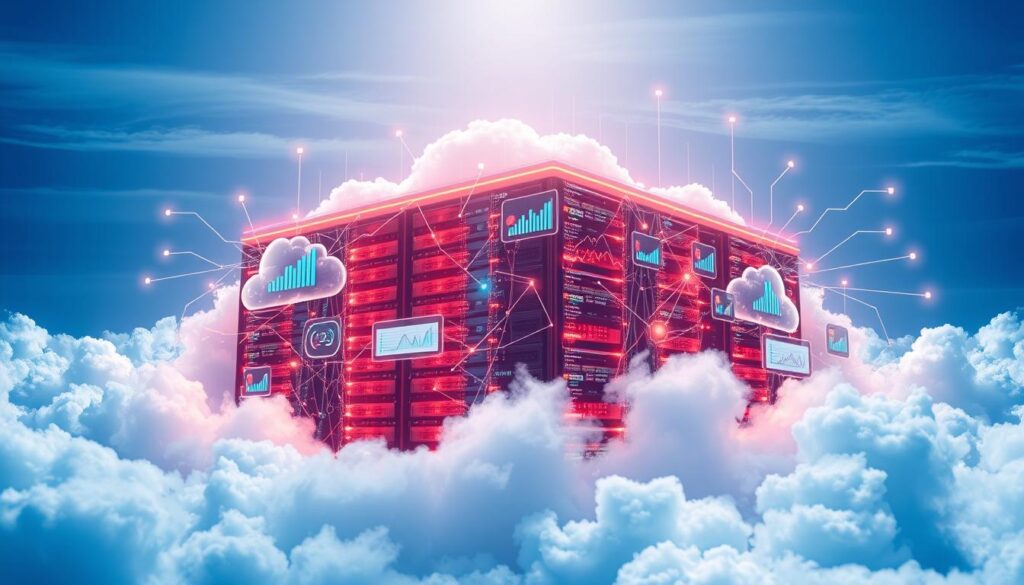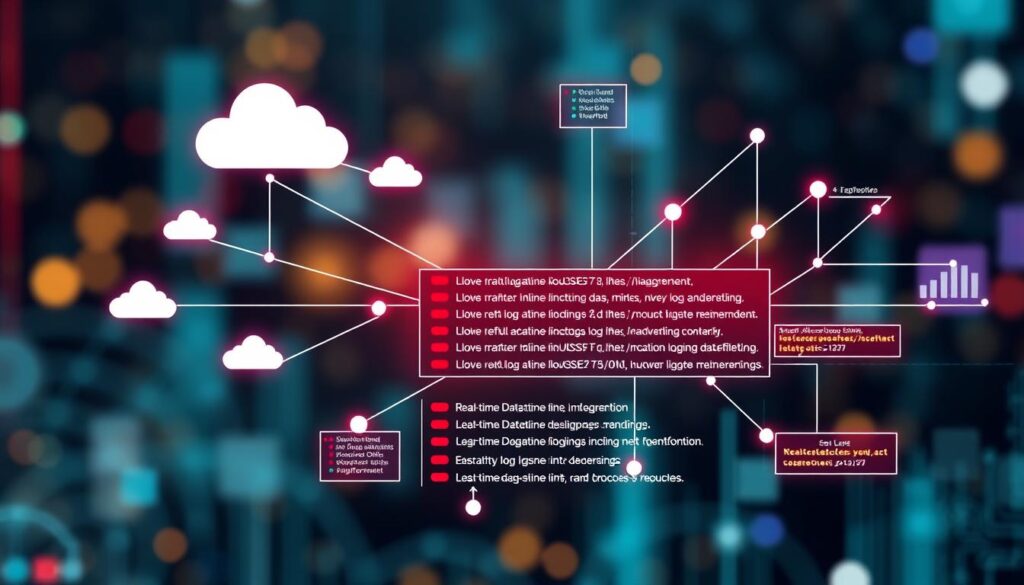
Did you know that using cloud observability services can cut downtime by up to 50%? It also boosts application performance. In today’s digital world, keeping infrastructure transparent and optimizing app performance is key. As more businesses use complex multi-cloud setups, managing these systems gets harder. It’s vital to have good resource optimization strategies.
Our cloud observability services give you deep insights into your apps and cloud infrastructure. We show you where your system might be slow, helping you make it better. This makes your system more reliable, improving how users experience your apps. We also help you manage your cloud resources better, saving you money.
We offer top-notch log management, advanced performance tracking, and distributed tracing. These tools help you understand and improve your cloud systems. Our team and partnerships with major cloud providers mean we offer solutions that are both effective and tailored to your needs.
Key Takeaways
- Cloud observability services can drastically reduce downtime and enhance application performance.
- Infrastructure transparency is crucial for understanding and optimizing cloud system behavior.
- Implementing cloud observability aids in resource optimization and cost reduction.
- Advanced performance monitoring and distributed tracing are critical for managing complex systems.
- Partnering with top cloud providers ensures robust, tailored solutions for businesses.
Understanding Cloud Observability
As we move to cloud-native tech like Kubernetes, systems get more complex and big. Cloud observability helps manage this by collecting and analyzing data. This gives us cloud environment insights.
What is Cloud Observability?
Cloud observability is a way to gather and analyze metrics, logs, and traces. It lets us deeply understand our cloud environment. It’s more than just monitoring. It helps us predict system behavior through dynamic data, aiding in proactive problem-solving.
The Importance of Cloud Observability
Cloud observability is key for keeping systems running smoothly. It gives IT teams quick insights into system performance. This makes monitoring, alerting, and cloud infrastructure analysis more effective. By using observability tools, businesses can improve system performance and security, leading to better user experiences.
Differences Between Cloud Observability and Cloud Monitoring
Cloud observability and monitoring both aim to keep systems healthy, but they differ. Monitoring is reactive, focusing on set metrics and thresholds. Observability is proactive, using a wide range of data to understand our cloud infrastructure. This proactive approach helps find and fix issues early, unlike traditional monitoring.
Here’s a comparative analysis illustrating the key aspects:
| Aspect | Cloud Monitoring | Cloud Observability |
|---|---|---|
| Approach | Reactive | Proactive |
| Data Sources | Metrics | Metrics, Logs, Traces |
| Scope | Predefined Metrics | Holistic System Understanding |
| Goals | Issue Detection | Issue Detection & Resolution |
Key Benefits of Cloud Observability
Cloud observability greatly improves managing digital infrastructure. Tools like Splunk Observability Cloud offer over 200 integrations. This helps organizations get better insights and work more efficiently.
Performance Optimization
Cloud observability is key for improving app and infrastructure performance. It helps teams find and fix issues quickly. This ensures resources are used well, avoiding waste and saving money.
It also gives a clear view of data from major cloud providers. This makes apps run smoothly and systems easy to manage.
Error Detection and Resolution
Cloud observability is great at finding and fixing errors. It helps apps run reliably, making users happy. It also lets teams quickly find and fix problems.
Tools like FusionReactor help keep data in line with rules. This makes it easier to follow rules and stay compliant.
Enhancing Operational Efficiency
Cloud observability also boosts operational efficiency. It gives teams deep insights into how systems work. This helps them make better decisions and improve user experiences.
It also uses machine learning to fix problems automatically. This keeps systems running smoothly and efficiently. Plus, it helps manage resources better across different clouds.
| Benefit | Impact |
|---|---|
| Performance Optimization | Address performance bottlenecks, optimize resource usage, reduce costs |
| Error Detection and Resolution | Swift error identification, enhanced reliability, improved user experience |
| Enhancing Operational Efficiency | Streamlined release cycles, better decision-making, automated repairs |
Best Practices for Implementing Cloud Observability
Setting up cloud observability needs a detailed plan for monitoring and fixing cloud apps. Here are three key steps to make your cloud observability better.
Leverage High-Quality, Structured Logging
Good, structured logging is key for handling cloud app complexities. It makes analysis easier and helps solve problems fast. In microservices setups, it spots patterns and gives deep insights for microservices architecture optimization.
Using this method helps us get useful info from logs. It leads to better predictions and smarter decisions.
Embrace Distributed Tracing
Distributed tracing gives a detailed look at how requests are handled. It’s very helpful in microservices setups, showing where things slow down. By using distributed tracing, we can better watch app performance and keep systems healthy.
It also makes sure all microservices work well together. Tools that follow standardized protocols help us see everything clearly, making it easier to find and fix problems.
Utilize AI and Machine Learning
AI and machine learning can really boost our observability. They help find odd patterns and predict when things might go wrong. These tools help us deal with security threats better and manage resources more efficiently.
They also help us spot problems early and fix them fast. Using machine learning makes our observability strategy stronger, helping us detect and act on issues quickly.
| Observability Tool | Category | Key Features | Recommended Best Practices |
|---|---|---|---|
| Splunk | Commercial | Enterprise-grade for logs | High customization, compliance with industry standards |
| Elasticsearch with Kibana (ELK Stack) | Open-source | Logs with customization and flexibility | Using standardized protocols for seamless integration |
| Datadog | Commercial | Hosted solution for metrics | Wide integrations, focus on scalability |
| Prometheus | Open-source | Scalability and reliability for self-hosted metrics | Efficient resource consumption, integrates well with microservices |
By following these best practices, we can build a strong observability system. It gives us full view of cloud apps and makes things more efficient and effective.
Multi-Cloud Environments and Observability Challenges
In recent years, more organizations have moved to multi-cloud environments. Gartner reports 75% of companies now use multi-cloud models, up from 49% five years ago. This shift brings benefits like redundancy and risk mitigation but also poses challenges.
Understanding Multi-Cloud Environments
Multi-cloud architecture lets companies use different cloud providers’ strengths. This improves flexibility and performance. Most use 2 to 4 public clouds, as ESG research shows.
However, managing security across these platforms is crucial. It helps prevent cyber threats. A unified observability strategy is needed for smooth operations.
Common Observability Challenges in Multi-Cloud Setups
Tracking in multi-cloud setups is complex. Data distribution can create silos, making monitoring hard. Tools like SolarWinds Observability Self-Hosted help by centralizing insights.
A national communications provider saved a lot by using such a tool. It shows the benefits of streamlined observability. A unified approach also helps manage cloud costs.
To operate smoothly in multi-cloud environments, businesses need tools that offer full visibility. These tools should use AI and machine learning. This ensures data governance and predicts trends. Learn more about observability in multi-cloud environments here.
FAQ
What is Cloud Observability?
Cloud observability is a way to collect and analyze data in cloud environments. It goes beyond just monitoring. It uses metrics, logs, and traces to understand the system fully. This helps in making the system better and solving problems faster.
Why is Cloud Observability important?
Cloud observability is key for quick insights and better management. It helps keep systems running smoothly and protects data. It also makes systems more reliable and improves user experience.
How is Cloud Observability different from Cloud Monitoring?
Cloud monitoring reacts to set metrics. Cloud observability is proactive and looks at more data types. It gives a complete view of the cloud, helping solve problems and improve systems.
How does Cloud Observability aid in Performance Optimization?
It finds where applications and systems slow down. This lets businesses use cloud resources better. It saves money and makes systems more reliable and user-friendly.
What role does Cloud Observability play in Error Detection and Resolution?
It gives deep insights into system operations. This helps find and fix errors quickly. It makes systems more reliable and improves user experience.
How does Cloud Observability enhance Operational Efficiency?
It gives full visibility into cloud systems. This helps manage resources better, cut costs, and improve app performance. It also helps quickly find and fix threats, keeping data safe.
What are some best practices for implementing Cloud Observability?
Good logging is a top practice. It makes analysis and fixing issues easier. Using distributed tracing in microservices is also important. It helps understand how requests are handled. AI and machine learning make observability better by automating analysis and finding unusual patterns.
What are the common challenges in Multi-Cloud Environments?
Multi-cloud setups face issues like data silos and tool fragmentation. These make monitoring and analysis hard.
How can we overcome observability challenges in Multi-Cloud Setups?
Using uniform platforms and centralized data collection helps. AI and machine learning also play a big role. They ensure data is handled consistently, reducing blind spots and giving a full view of the infrastructure.
Future App Studios is an award-winning software development & outsourcing company. Our team of experts is ready to craft the solution your company needs.










